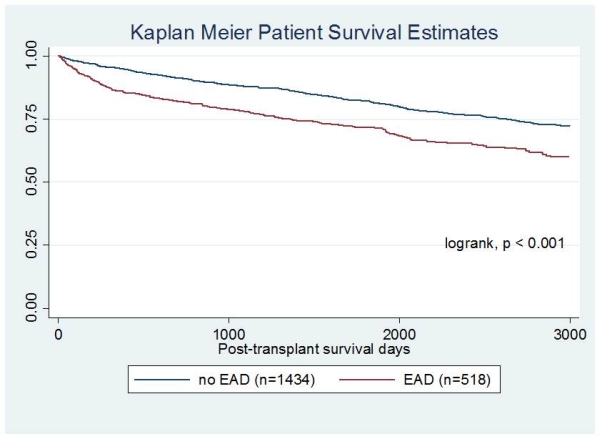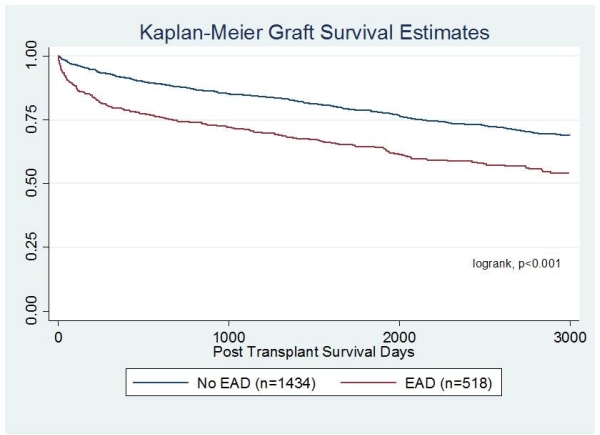Early Allograft Dysfunction Causes Inferior Patient and Allograft Survival in Liver Transplantation; an Experience of 1952 Consecutive Liver Transplants
Transplantation, Mayo Clinic, Jacksonville, FL.
Meeting: 2015 American Transplant Congress
Abstract number: 105
Keywords: Liver grafts, Liver transplantation, Outcome
Session Information
Session Name: Concurrent Session: Liver Retransplantation and Other Complications
Session Type: Concurrent Session
Date: Sunday, May 3, 2015
Session Time: 4:00pm-5:30pm
 Presentation Time: 4:12pm-4:24pm
Presentation Time: 4:12pm-4:24pm
Location: Room 115-AB
Background: Early allograft dysfunction (EAD) in liver transplantation (LT) is a useful intermediate outcome measure to predict graft loss or mortality. We sought to investigate the incidence of and reasons for EAD and its role in predicting graft loss and mortality after LT in a large volume LT program.
Methods: Retrospective review of primary LT between 2002-2013. All donor, recipient and perioperative data was obtained from chart review. EAD was defined by the presence of 1 or more of the following variables: (1) bilirubin ≥10 mg/dL on postoperative day 7, (2) INR ≥1.6 on postoperative day 7, and (3) an aminotransferase level (ALT or AST) ≥ 2000 IU mL within the first 7 post-operative days.
Results: In 1952 consecutive LT we found that 518 (26.5%) patients had EAD. 1 and 5 year survival for patients who did not have EAD vs. those who did were 94.7% vs. 85.1% and 78.8% vs. 65.2%, respectively (p <0.01). 1 and 5 year allograft survival for patients who did not have EAD vs. those who did were 91.4% vs. 78.6% and 74.8% vs. 57.2%, respectively (p <0.01).
 Multivariate analysis demonstrated significant association of development of EAD with recipient's ventilator status before LT (OR: 3.06; P <0.01), donor age (OR: 1.15; P <0.01), DCD donor (OR: 2.55; P <0.01), donor liver mass (OR: 1.07; P <0.01), allograft steatosis (OR: 2.52; P <0.01), CIT (OR: 1.08; P = 0.04), blood transfusion (OR: 1.02; P = 0.02), and operative time (OR: 1.14; P <0.001).
Multivariate analysis demonstrated significant association of development of EAD with recipient's ventilator status before LT (OR: 3.06; P <0.01), donor age (OR: 1.15; P <0.01), DCD donor (OR: 2.55; P <0.01), donor liver mass (OR: 1.07; P <0.01), allograft steatosis (OR: 2.52; P <0.01), CIT (OR: 1.08; P = 0.04), blood transfusion (OR: 1.02; P = 0.02), and operative time (OR: 1.14; P <0.001).
Conclusion: This is the largest LT cohort documenting effect of EAD in graft and patient survival. EAD is associated with inferior patients and allograft survival. Future efforts to prevent EAD should be the focus to increase outcomes after LT.
To cite this abstract in AMA style:
Lee D, Croome K, Burns J, Perry D, Nguyen J, Crespo H, Taner C. Early Allograft Dysfunction Causes Inferior Patient and Allograft Survival in Liver Transplantation; an Experience of 1952 Consecutive Liver Transplants [abstract]. Am J Transplant. 2015; 15 (suppl 3). https://atcmeetingabstracts.com/abstract/early-allograft-dysfunction-causes-inferior-patient-and-allograft-survival-in-liver-transplantation-an-experience-of-1952-consecutive-liver-transplants/. Accessed January 7, 2026.« Back to 2015 American Transplant Congress
